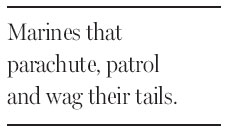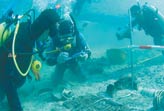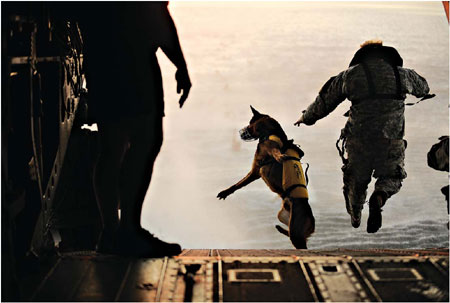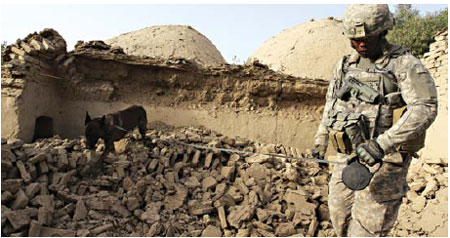Society
Canine soldiers, beloved and battle-tested
Updated: 2011-05-22 08:28
By Elisabeth Bumiller (New York Times)
|
Military dogs, like this one in water training, are the best tool the Marines have to sniff out improvised explosive devices. Manuel J. Martinez / United States Air Force, Via Reuters |
|
Of 350 Marine dogs in Afghanistan, 20 have been killed in action. The military plans to increase the number of canines in the country to 650. Joao Silva for The New York Times |

WASHINGTON - American Marines were on a foot patrol last fall in the Taliban stronghold of Marja, Afghanistan, when they shot and killed a lethal threat: a local dog that attacked the Marines' Labrador retriever.
If the Labrador had been hurt, the Marines would have lost their best weapon for detecting roadside bombs - and would have called for a medevac helicopter. An attack on the Lab was an attack on a fellow warrior.
As Captain Manuel Zepeda, the commander of Company F, Second Battalion, Sixth Marines, put it that day, "We consider the dog another Marine."
The classified canine that went on the Navy Seals' raid of Osama bin Laden's compound on May 2 has generated a wave of interest in military dogs, which have been used by the United States since at least World War I and are increasingly being deployed in Afghanistan.
American troops may be starting to leave Afghanistan this summer, but more dogs are going in. By the end of the year, nearly 650 bomb-sniffing dogs are expected to be in the country. There are some 2,700 dogs on active duty in the American military. Before the September 11 attacks, there were 1,800.
Military dogs are used for protection, pursuit, tracking, and search and rescue, but they are also increasingly relied on to sniff out the homemade bombs that cause the vast majority of American casualties in Afghanistan. So far, no technology can do better.
Within the military, the breeds of choice are generally the German shepherd and a Belgian shepherd, or Malinois, but Marines in Afghanistan rely on pure-bred Labrador retrievers because of the dogs' good noses and nonaggressive, eager-to-please temperaments. The dogs now accompany many Marine foot patrols in Helmand Province in southern Afghanistan, wandering off-leash 90 meters or more in front as bomb detectors. It is the vital work of an expensively trained canine (as high as $40,000 per dog), but at the end of a sweltering day, sometimes a Lab is still a Lab.

Last spring on a patrol in Helmand, a Lab, Tango, was leading a small group of Marines into a village when the dog suddenly went down on all fours, wagging his tail - a sign that he had detected explosives nearby. The patrol froze. No bomb was found, but on the way back the dog, miserable in the 39-degree Celsius heat, leaped into an irrigation canal. But then he could not climb back up the steep bank. A Marine, swearing lustily, finally jumped into the canal and carried the dog out.
Few of the heart-tugging stories of Marines in battle and their Labs have had the emotional impact of that of Private First Class Colton W. Rusk, a 20-year-old machine gunner and dog handler who was killed in December by sniper fire in Helmand. During his deployment, Private Rusk sent his parents pictures and news about his beloved bomb dog, Eli. When Private Rusk was shot, Marine officers told his parents, Eli crawled on top of their son to try to protect him.
The 3-year-old Eli was the first name in a list of survivors in Private Rusk's obituary. He was adopted in February by Private Rusk's parents, Darrell and Kathy Rusk. "He's a big comfort to us," Kathy Rusk said from her home in Orange Grove, Texas. When the Rusks brought Eli home for the first time, "The first place he went was Colton's room," Mrs. Rusk said. "He sniffed around and jumped up on his bed."
So far, 20 Labrador retrievers out of 350 have been killed in action since the Marines began the canine program in 2007, most in explosions of homemade bombs, Marine officials said. Within the Special Operations Command, the home of the dog that went on the Bin Laden mission, some 34 dogs were killed in the line of duty between 2006 and 2009, said Major Wes Ticer. The dogs, which sometimes go on as many as four deployments, retire from the military at age 8 or 9.
In mid-May Rebecca Frankel, the deputy managing editor of ForeignPolicy.com, posted a "War Dog" photo essay, with pictures of dogs jumping out of helicopters, skydiving and relaxing with Marines. It went viral, with 6.5 million page views to date - a site record.
"I think people go weak at the knees for these dogs," Ms. Frankel said. "But their contribution is significant. These are serious dogs."
The New York Times
Specials

Suzhou: Heaven on Earth
Time-tested adages sing praises of Suzhou, and Michael Paul Franklin finds it's not hard to understand why on a recent visit.

The sky's the limit
Chinese airline companies are increasingly recruiting pilots and flight attendants as the industry experiences rapid expansion.

Diving into history
China's richest cultural heritage may lie in the deep, like exhibits in a giant underwater museum.

